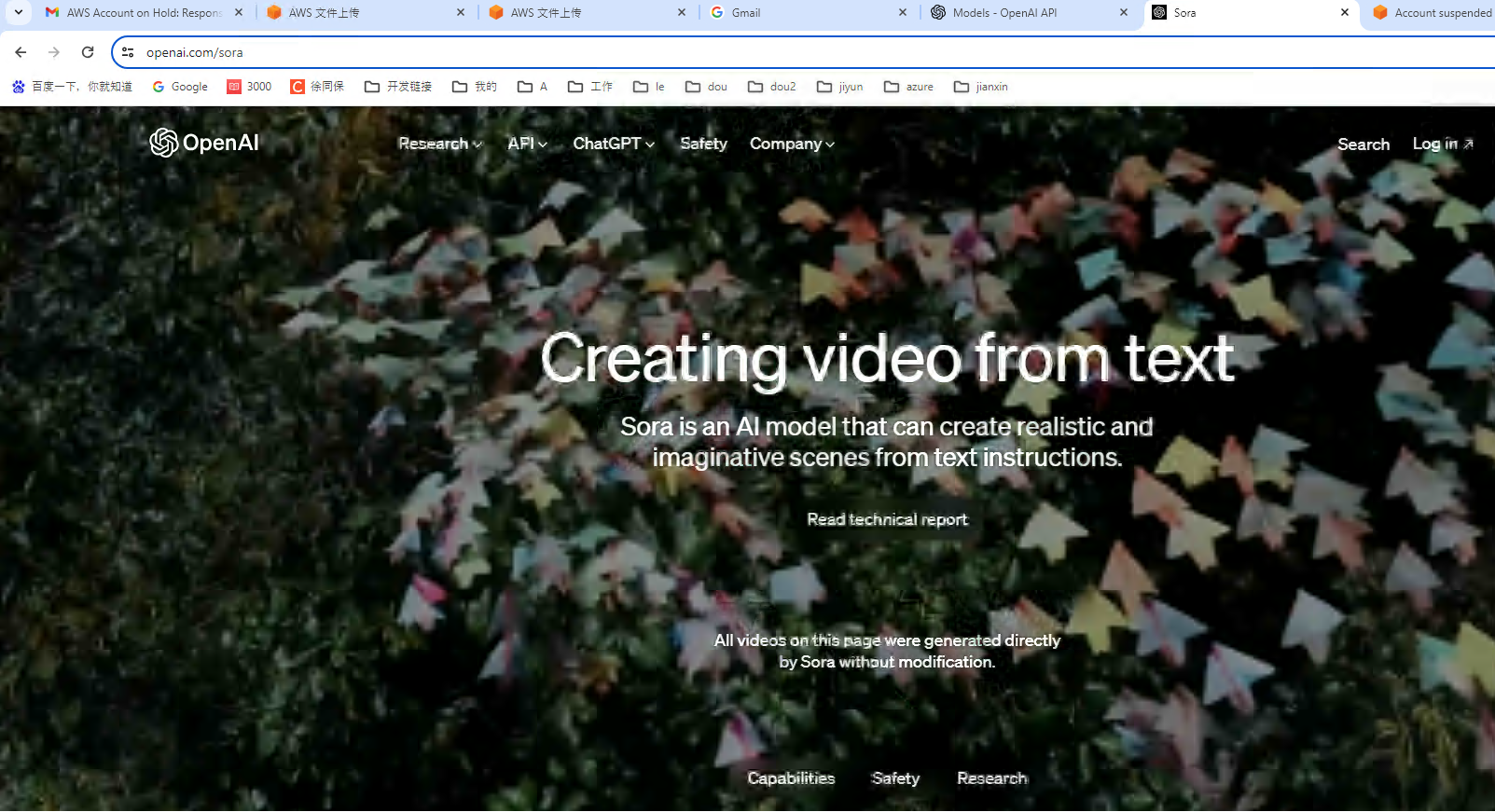sora简介

We’re teaching AI to understand and simulate the physical world in motion, with the goal of training models that help people solve problems that require real-world interaction.
Introducing Sora, our text-to-video model. Sora can generate videos up to a minute long while maintaining visual quality and adherence to the user’s prompt.
我们正在教授人工智能理解和模拟运动中的物理世界,目的是训练模型,帮助人们解决需要现实世界互动的问题。
介绍索拉,我们的文本到视频模型。Sora可以生成长达一分钟的视频,同时保持视觉质量并遵守用户的提示。
Today, Sora is becoming available to red teamers to assess critical areas for harms or risks. We are also granting access to a number of visual artists, designers, and filmmakers to gain feedback on how to advance the model to be most helpful for creative professionals.
We’re sharing our research progress early to start working with and getting feedback from people outside of OpenAI and to give the public a sense of what AI capabilities are on the horizon.
如今,红队队员可以使用索拉来评估关键区域的危害或风险。我们还允许一些视觉艺术家、设计师和电影制作人获得反馈,了解如何推进模型,使其对创意专业人士最有帮助。
我们正在尽早分享我们的研究进展,以便开始与OpenAI以外的人合作并从他们那里获得反馈,并让公众了解人工智能的能力。
Sora is able to generate complex scenes with multiple characters, specific types of motion, and accurate details of the subject and background. The model understands not only what the user has asked for in the prompt, but also how those things exist in the physical world.
Sora 能够生成具有多个角色、特定运动类型以及主题和背景的准确细节的复杂场景。该模型不仅了解用户在提示中的要求,还了解这些东西在物理世界中是如何存在的。
The model has a deep understanding of language, enabling it to accurately interpret prompts and generate compelling characters that express vibrant emotions. Sora can also create multiple shots within a single generated video that accurately persist characters and visual style.
该模型对语言有着深刻的理解,使其能够准确地解释提示,并生成令人信服的人物,表达充满活力的情感。Sora 还可以在一个生成的视频中创建多个镜头,准确地保持角色和视觉风格。
The current model has weaknesses. It may struggle with accurately simulating the physics of a complex scene, and may not understand specific instances of cause and effect. For example, a person might take a bite out of a cookie, but afterward, the cookie may not have a bite mark.
The model may also confuse spatial details of a prompt, for example, mixing up left and right, and may struggle with precise descriptions of events that take place over time, like following a specific camera trajectory.
目前的模式有弱点。它可能难以准确模拟复杂场景的物理特性,也可能无法理解因果关系的具体实例。例如,一个人可能咬了一口饼干,但之后,饼干可能没有咬痕。
该模型还可能混淆提示的空间细节,例如,混淆左右,并可能难以准确描述随着时间的推移发生的事件,例如遵循特定的相机轨迹。
Safety
We’ll be taking several important safety steps ahead of making Sora available in OpenAI’s products. We are working with red teamers — domain experts in areas like misinformation, hateful content, and bias — who will be adversarially testing the model.
We’re also building tools to help detect misleading content such as a detection classifier that can tell when a video was generated by Sora. We plan to include C2PA metadata in the future if we deploy the model in an OpenAI product.
In addition to us developing new techniques to prepare for deployment, we’re leveraging the existing safety methods that we built for our products that use DALL·E 3, which are applicable to Sora as well.
For example, once in an OpenAI product, our text classifier will check and reject text input prompts that are in violation of our usage policies, like those that request extreme violence, sexual content, hateful imagery, celebrity likeness, or the IP of others. We’ve also developed robust image classifiers that are used to review the frames of every video generated to help ensure that it adheres to our usage policies, before it’s shown to the user.
We’ll be engaging policymakers, educators and artists around the world to understand their concerns and to identify positive use cases for this new technology. Despite extensive research and testing, we cannot predict all of the beneficial ways people will use our technology, nor all the ways people will abuse it. That’s why we believe that learning from real-world use is a critical component of creating and releasing increasingly safe AI systems over time.
安全
在OpenAI的产品中提供Sora之前,我们将采取几个重要的安全措施。我们正在与红队合作 — 错误信息、仇恨内容和偏见等领域的领域专家 — 谁将对模型进行对抗性测试。
我们还在构建工具来帮助检测误导性内容,例如检测分类器,它可以判断视频是由索拉生成的。如果我们在OpenAI产品中部署该模型,我们计划在未来包括C2PA元数据。
除了开发新技术为部署做准备外,我们还利用了我们为使用DALL·E 3的产品构建的现有安全方法,这些方法也适用于索拉。
例如,一旦在OpenAI产品中,我们的文本分类器就会检查并拒绝违反我们使用政策的文本输入提示,比如那些要求极端暴力、性内容、仇恨图像、名人肖像或他人IP的提示。我们还开发了强大的图像分类器,用于审查生成的每个视频的帧,以帮助确保它在向用户显示之前符合我们的使用策略。
我们将让世界各地的政策制定者、教育工作者和艺术家参与进来,了解他们的担忧,并确定这项新技术的积极使用案例。尽管进行了广泛的研究和测试,但我们无法预测人们使用我们技术的所有有益方式,也无法预测人们滥用技术的所有方式。这就是为什么我们认为,随着时间的推移,从现实世界的使用中学习是创建和发布越来越安全的人工智能系统的关键组成部分。
Research techniques
Sora is a diffusion model, which generates a video by starting off with one that looks like static noise and gradually transforms it by removing the noise over many steps.
Sora is capable of generating entire videos all at once or extending generated videos to make them longer. By giving the model foresight of many frames at a time, we’ve solved a challenging problem of making sure a subject stays the same even when it goes out of view temporarily.
Similar to GPT models, Sora uses a transformer architecture, unlocking superior scaling performance.
We represent videos and images as collections of smaller units of data called patches, each of which is akin to a token in GPT. By unifying how we represent data, we can train diffusion transformers on a wider range of visual data than was possible before, spanning different durations, resolutions and aspect ratios.
Sora builds on past research in DALL·E and GPT models. It uses the recaptioning technique from DALL·E 3, which involves generating highly descriptive captions for the visual training data. As a result, the model is able to follow the user’s text instructions in the generated video more faithfully.
In addition to being able to generate a video solely from text instructions, the model is able to take an existing still image and generate a video from it, animating the image’s contents with accuracy and attention to small detail. The model can also take an existing video and extend it or fill in missing frames. Learn more in our technical report.
Sora serves as a foundation for models that can understand and simulate the real world, a capability we believe will be an important milestone for achieving AGI.
研究技术
Sora是一个扩散模型,它从一个看起来像静态噪声的视频开始生成视频,并通过多次去除噪声来逐渐变换视频。
索拉能够一次生成整个视频,或者扩展生成的视频以使其更长。通过一次为模型提供多帧的前瞻性,我们解决了一个具有挑战性的问题,即确保主题即使在暂时离开视线时也保持不变。
与GPT模型类似,Sora使用了转换器架构,释放了卓越的扩展性能。
我们将视频和图像表示为称为补丁的较小数据单元的集合,每个数据单元类似于GPT中的令牌。通过统一我们表示数据的方式,我们可以在比以前更广泛的视觉数据上训练扩散转换器,跨越不同的持续时间、分辨率和纵横比。
Sora建立在过去对DALL·E和GPT模型的研究基础上。它使用了DALL·E 3中的重述技术,该技术涉及为视觉训练数据生成高度描述性的字幕。结果,模型能够更忠实地遵循用户在生成的视频中的文本指令。
除了能够仅根据文本指令生成视频外,该模型还能够获取现有的静止图像并从中生成视频,从而准确地动画化图像内容,并注意小细节。该模型还可以获取现有视频并对其进行扩展或填充缺失的帧。在我们的技术报告中了解更多信息。
索拉是能够理解和模拟真实世界的模型的基础,我们相信这一能力将是实现AGI的重要里程碑。
我开发的chatgpt网站:



